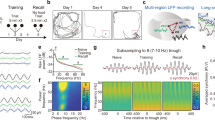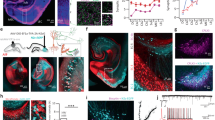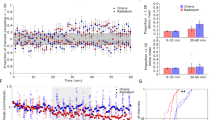Abstract
A dialogue between the hippocampus and the neocortex is thought to underlie the formation, consolidation and retrieval of episodic memories1,2,3,4, although the nature of this cortico-hippocampal communication is poorly understood. Using selective electrolytic lesions in rats, here we examined the role of the direct entorhinal projection (temporoammonic, TA) to the hippocampal area CA1 in short-term (24 hours) and long-term (four weeks) spatial memory in the Morris water maze. When short-term memory was examined, both sham- and TA-lesioned animals showed a significant preference for the target quadrant. When re-tested four weeks later, sham-lesioned animals exhibited long-term memory; in contrast, the TA-lesioned animals no longer showed target quadrant preference. Many long-lasting memories require a process called consolidation, which involves the exchange of information between the cortex and hippocampus3,5,6. The disruption of long-term memory by the TA lesion could reflect a requirement for TA input during either the acquisition or consolidation of long-term memory. To distinguish between these possibilities, we trained animals, verified their spatial memory 24 hours later, and then subjected trained animals to TA lesions. TA-lesioned animals still exhibited a deficit in long-term memory, indicating a disruption of consolidation. Animals in which the TA lesion was delayed by three weeks, however, showed a significant preference for the target quadrant, indicating that the memory had already been adequately consolidated at the time of the delayed lesion. These results indicate that, after learning, ongoing cortical input conveyed by the TA path is required to consolidate long-term spatial memory.
This is a preview of subscription content, access via your institution
Access options
Subscribe to this journal
Receive 51 print issues and online access
$199.00 per year
only $3.90 per issue
Buy this article
- Purchase on Springer Link
- Instant access to full article PDF
Prices may be subject to local taxes which are calculated during checkout




Similar content being viewed by others
References
Morris, R. G. M., Garrud, P., Rawlins, J. N. P. & O'Keefe, J. Place navigation impaired in rats with hippocampal lesions. Nature 297, 681–683 (1982)
Eichenbaum, H. A cortical-hippocampal system for declarative memory. Nature Rev. Neurosci. 1, 41–50 (2001)
Scoville, W. B. & Milner, B. Loss of recent memory after bilateral hippocampal lesions. J. Neuropsychiatry Clin. Neurosci. 12, 103–113 (1957)
Squire, L. R. & Zola, S. M. Amnesia, memory and brain systems. Phil. Trans. R. Soc. Lond. B 352, 1663–1673 (1997)
McGaugh, J. L. Time-dependent processes in memory storage. Science 153, 1351–1358 (1966)
Squire, L. R. & Alvarez, P. Retrograde amnesia and memory consolidation: a neurobiological perspective. Curr. Opin. Neurobiol. 5, 169–177 (1995)
Skelton, R. W. & McNamara, R. K. Bilateral knife cuts to the perforant path disrupt spatial learning in the Morris water maze. Hippocampus 2, 73–80 (1992)
Eichenbaum, H., Stewart, C. & Morris, R. G. M. Hippocampal representation in place learning. J. Neurosci. 10, 3531–3542 (1990)
Sutherland, R. J., Whishaw, I. Q. & Kolb, B. A behavioural analysis of spatial localization following electrolytic, kainate- or colchicine-induced damage to the hippocampal formation in the rat. Behav. Brain Res. 7, 133–153 (1983)
McNaughton, B. L., Barnes, C. A., Meltzer, J. & Sutherland, R. J. Hippocampal granule cells are necessary for normal spatial learning but not for spatially-selective pyramidal cell discharge. Exp. Brain Res. 76, 485–496 (1989)
Jarrard, L. E. Selective hippocampal lesions and behaviour: effects of kainic acid lesions on performance of place and cue tasks. Behav. Neurosci. 97, 873–889 (1983)
Brun, V. H. et al. Place cells and place recognition maintained by the direct entorhinal-hippocampal circuitry. Science 296, 2243–2246 (2002)
Nakazawa, K. et al. Requirement for hippocampal CA3 NMDA receptors in associative memory recall. Science 297, 211–218 (2002)
Colbert, C. M. & Levy, W. B. Long-term potentiation of perforant path synapses in hippocampal CA1 in vitro. Brain Res. 606, 87–91 (1993)
Remondes, M. & Schuman, E. M. Direct cortical input modulates plasticity and spiking in CA1 pyramidal neurons. Nature 416, 736–740 (2002)
Remondes, M. & Schuman, E. M. Properties of early- and late-phase LTP at temporoammonic-CA1 synapses. Learning Memory 10, 247–252 (2003)
Dvorak-Carbone, H. & Schuman, E. M. Patterned activity in stratum lacunosum moleculare inhibits CA1 pyramidal neuron firing. J. Neurophys. 82, 3213–3222 (1999)
Dvorak-Carbone, H. & Schuman, E. M. Long-term depression of temporoammonic-CA1 hippocampal synaptic transmission. J. Neurophys. 81, 1036–1044 (1999)
Otmakhova, N. A. & Lisman, J. E. Dopamine selectively inhibits the direct cortical pathway to the CA1 hippocampal region. J. Neurosci. 19, 1437–1445 (1999)
El-Ghundi, M. et al. Spatial learning deficit in dopamine D1 receptor knockout mice. Eur. J. Pharmacol. 383, 95–106 (1999)
Li, S., Cullen, W. K., Anwyl, R. & Rowan, M. J. Dopamine-dependent facilitation of LTP induction in hippocampal CA1 by exposure to spatial novelty. Nature Neurosci. 6, 526–531 (2003)
Riedel, G. et al. Reversible neural inactivation reveals hippocampal participation in several memory process. Nature Neurosci. 2, 898–905 (1999)
Frankland, P. W., O'Brien, C. O., Ohno, M., Kirkwood, A. & Silva, A. J. Alpha-CAMKII-dependent plasticity in the cortex is required for permanent memory. Nature 411, 309–313 (2001)
Siapas, A. G. & Wilson, M. A. Coordinated interactions between hippocampal ripples and cortical spindles during slow-wave sleep. Neuron 21, 1123–1128 (1998)
Sirota, A., Csicsvari, J., Bhul, D. & Buzsaki, G. Communication between neocortex and hippocampus during sleep in rodents. Proc. Natl Acad. Sci. USA 100, 2065–2069 (2003)
Wilson, M. A. & McNaughton, B. L. Reactivation of hippocampal ensemble memories during sleep. Science 265, 676–679 (1994)
Lee, A. K. & Wilson, M. A. Memory of sequential experience in the hippocampus during slow wave sleep. Neuron 36, 1183–1194 (2002)
Acknowledgements
We thank T. Siapas, G. Laurent, M. Sutton and other members of the Schuman laboratory for discussions. This work was supported by the Fundacao para a Ciencia e Technologia (FCT)—Portugal and the Howard Hughes Medical Institute.
Author information
Authors and Affiliations
Corresponding author
Ethics declarations
Competing interests
The authors declare that they have no competing financial interests.
Supplementary information
Supplementary Figure 1
Lesion data for animals included in the behavioural analyses shown in Figures 2 and 3. (JPG 97 kb)
Supplementary Figure 2
More TA lesion data for all animals included in the behavioural analyses. (JPG 117 kb)
Supplementary Figure 3
Visible platform data for all animals in all experiments. In addition, probe trial data for animals that received complete hippocampal lesions, and the sham and TA-lesioned animals probe trial at 24 hrs post-training. (JPG 110 kb)
Supplementary Methods
Methods used for surgical procedures, lesion execution and assessment and electrophysiology. (PDF 13 kb)
Rights and permissions
About this article
Cite this article
Remondes, M., Schuman, E. Role for a cortical input to hippocampal area CA1 in the consolidation of a long-term memory. Nature 431, 699–703 (2004). https://doi.org/10.1038/nature02965
Received:
Accepted:
Issue Date:
DOI: https://doi.org/10.1038/nature02965
This article is cited by
-
G-protein coupled estrogen receptor (GPER1) activation promotes synaptic insertion of AMPA receptors and induction of chemical LTP at hippocampal temporoammonic-CA1 synapses
Molecular Brain (2023)
-
YTHDF2 in dentate gyrus is the m6A reader mediating m6A modification in hippocampus-dependent learning and memory
Molecular Psychiatry (2023)
-
Mapping the spatial transcriptomic signature of the hippocampus during memory consolidation
Nature Communications (2023)
-
Entorhinal grid-like codes and time-locked network dynamics track others navigating through space
Nature Communications (2023)
-
Per2 Expression Regulates the Spatial Working Memory of Mice through DRD1-PKA-CREB Signaling
Molecular Neurobiology (2022)
Comments
By submitting a comment you agree to abide by our Terms and Community Guidelines. If you find something abusive or that does not comply with our terms or guidelines please flag it as inappropriate.



